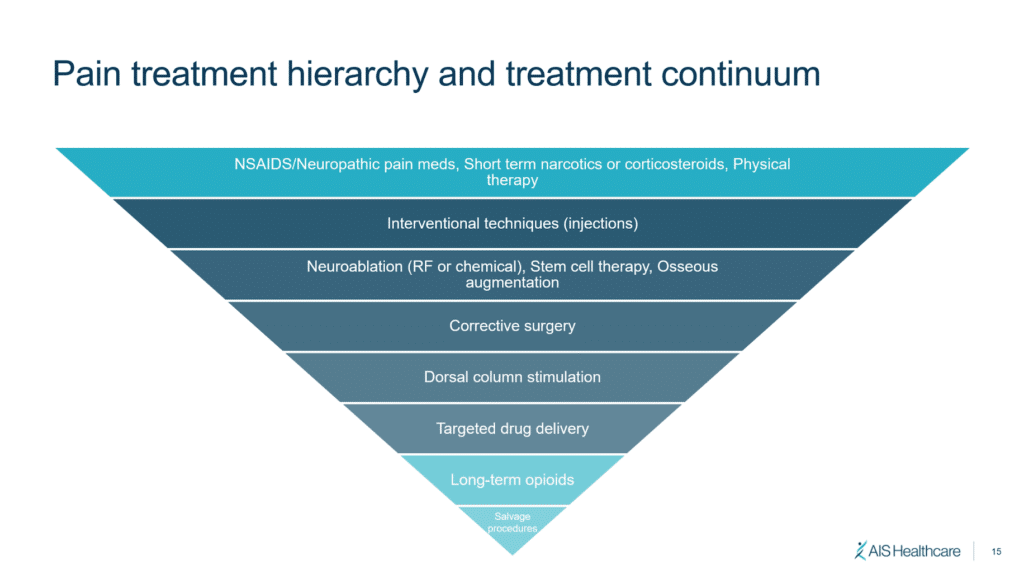Learn more about chronic pain and what you can do to find relief

Table of Contents
What is chronic pain?
Chronic pain is pain lasting longer than 6 months that continues to occur even though there is no recent injury to the body. Chronic pain is caused by abnormal firing of the nervous system when your body is not in danger of immediate injury.
For example, after breaking your arm, you can expect there to be pain for 3-6 months. This normal pain is your body letting you know to be careful when engaging in activities that could re-injure your arm. Chronic pain is when pain continues after the body has fully healed itself. For example, it is abnormal to have continued pain 12 months after breaking your arm as the bone should be healed. Your body shouldn’t be screaming, “avoid this activity! You’re at risk for re-injury!”
PHYSICIAN INSIGHT
Pain is considered abnormal when the body is at no immediate risk of injury. It is usually abnormal when pain lasts longer than 6 months.
Who is at risk?
Chronic pain is more common in older individuals, though it can occur at any age. You may be at higher risk for chronic pain if you meet the following criteria:
- Recent injury or repeated injuries
- Previous surgery
- Overweight
- Female
What causes chronic pain?
The most likely explanation for why chronic pain develops is inappropriate nerve healing. Rather than the nerve sending fewer pain signals over time, it continues to send the same number or more pain signals over time.
Any condition that damages nerves can be the cause of chronic pain including prior injuries, fibromyalgia, arthritis, prior surgery (failed back surgery syndrome), or degenerative disc disease (pain caused by wear and tear on the spine). Common causes of chronic pain are listed below.
Failed Back Surgery Syndrome (FBSS)
Pain after back surgery is very common and termed Failed Back Surgery Syndrome (FBSS). Pain that is still present 6-12 months after back surgery has a high likelihood of developing into chronic back pain. Failed Back Surgery Syndrome can be treated with physical therapy, steroid injections, spinal cord stimulation, and pain pumps.Vertebral Compression Fractures (VCFs)
Vertebral compression fractures (VCFs) are fractures that occur in the bones of the spine, termed vertebral bodies. Not only can vertebral compression fractures cause chronic back pain but they can also cause permanent changes in posture called kyphosis or hunchback.Herniated or Buldging Discs
Discs are the structures that cushion the spinal bones (vertebrae). When a disc bulges out of position and presses on a nerve root there is usually sudden, sharp pain that radiates down the legs or arms. Herniated discs can also result in chronic shooting pain.Degenerative Disc Disease (DDD)
Degenerative disc disease occurs when the discs between your vertebrae are worn down, resulting in pain and instability.Facet Syndrome
Facet joints are the structures that connect the spinal bones together. These joints provide stability and mobility when you twist or turn your spine. When the facet joints become inflamed, any action that requires the joint to move causes pain.Spinal Stenosis
Spinal stenosis occurs when the spinal canal becomes too narrow due to overgrowth of bone and ligaments surrounding the spinal cord. Spinal stenosis can sometimes lead to serious health problems such as paralysis.How is chronic pain treated?
There are a number of treatments for chronic pain spanning from conservative therapies like physical therapy all the way to invasive therapies like back surgery. Doctors usually use an “escalation strategy” where they will try to treat your pain with conservative therapies before moving to more invasive forms of therapy. Oral opioids are one of the last treatments for chronic pain. Common non-opioid treatments for chronic pain are listed below.

A few treatments for chronic pain
Lifestyle Changes
- Physical Therapy
- Exercise Regime
- Massage/Acupuncture
Non-Opioid Medications
- Over-the-counter (OTC) Medications (Tylenol, Aspirin, Ibuprofen)
- Antidepressant Medications (Cymbalta, Elavil, Effexor XR)
- Anti-Seizure Medications (Lyrica, Nuerontin)
Medical Procedures
-
Injection Therapy
Relieves inflammation around agitated nerves through steroid medications
-
Nerve Ablation
Reduces pain by using heat to permanently shut off pain fibers
-
Spinal Cord Stimulation
Neutralizes abnormal pain signals through small electric impulses
-
Back Surgery
Removes abnormal regions of bone and ligament that are pressing on the spinal cord
Now that you know more about chronic pain, keep reading to find out if you could be a good candidate for spinal cord stimulation!

Talk or text with a Care Coordinator for free
PainPoint Care Coordinators are here to answer your questions about treatments and help you schedule in-person visits.


